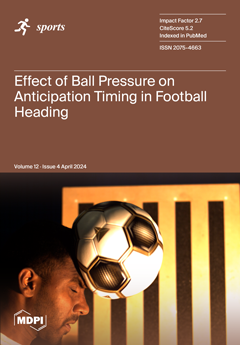Background: Swim performance can be reliant on strength and power. Standardisation of swim performance in different events, distances, and sexes can be completed using World Aquatics points, allowing for ranking of swimmers. The aim of this retrospective cross-sectional study was to assess whether relationships between World Aquatics points and dryland markers of performance existed in male and female elite swimmers separately and combined.
Methods: Dryland tests included Optojump
® photoelectric cell countermovement jump, countermovement jump reach with a Vertec
® system, standing broad jump using a tape measure, repetition maximum testing in the barbell back squat, barbell deadlift, and barbell bench press. Swim performance data and dryland test data on elite male (
n = 38) and female (
n = 20) Scottish swimmers from 2009–2017 were collected. Swim performance data were converted to World Aquatics federation points, and Bayesian linear regression analyses examined relationships between World Aquatics points and dryland performance tests: countermovement jump height (cm) using an Optojump
® photoelectric cells system, countermovement jump height (cm) using a Vertec
® device, standing broad jump distance (cm), relative strength (load lifted (kg) per kg of body mass) in the barbell bench press (kg/kg), barbell back squat (kg/kg), barbell deadlift (kg/kg).
Results: The Bayesian estimates of change of World Aquatics points for a unit change in jump-based measures were: Optojump
®—men = 0.6, women = 0.6, combined = 0.4; Vertec
®—men = 4.3, women = −1.6, combined = 2.4; standing broad jump—men = 0, women = 0, combined = 0.4. Strength-based measures were: barbell back squat—men = 2.3, women = 22, combined = −2.5; barbell deadlift—men = −5; barbell bench press—men = 41.8.
Conclusions: Dryland performance tests are not good predictors of World Aquatics points and should rather be used for assessing training quality and monitoring injury risks.
Full article






